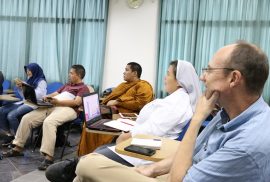Anang Alfian | CRCS | Class Journal
 For new CRCS students, learning different things every day, getting involved in the academic activities, as well as completing weekly assignments are truly challenging. Take, for example, the third meeting of the Academic Study of Religion taught by Dr. Samsul Maarif, aka Mas Anchu. That afternoon, we had a nice discussion about two classical theories of religion, from E.B. Tylor and James A. Frazer, both of whom perceived religion as a failed epistemology and constructed by society. This course introduces students to the classical theories of religion and their significances for explaining today’s religious phenomena from a number of disciplines including anthropology, sociology, psychology, history, philosophy, theology, and others. As interdisciplinary study, the Academic Study of Religion examines the complexity of religious phenomena and academic discourse around it.
For new CRCS students, learning different things every day, getting involved in the academic activities, as well as completing weekly assignments are truly challenging. Take, for example, the third meeting of the Academic Study of Religion taught by Dr. Samsul Maarif, aka Mas Anchu. That afternoon, we had a nice discussion about two classical theories of religion, from E.B. Tylor and James A. Frazer, both of whom perceived religion as a failed epistemology and constructed by society. This course introduces students to the classical theories of religion and their significances for explaining today’s religious phenomena from a number of disciplines including anthropology, sociology, psychology, history, philosophy, theology, and others. As interdisciplinary study, the Academic Study of Religion examines the complexity of religious phenomena and academic discourse around it.
Before the meeting, we had to submit a response paper of the given material as warming up before we dive into the subject. The response paper also quite useful to make students more engage with the class discussion. At the first, it might not be easy for us to read around sixty pages and make response papers as well as put our reflection to the issue. Yet, we felt like getting used to it after three other assignments from other subjects. During the class, Dr. Samsul Maarif, our lecturer, divided us into four groups. We were being trained to argue and debate about how Tylor and Frazer differed in conceptualizing the origins of religion. Tylor claimed that animism is the origin of religion, while Frazer argued that the magic is. Moreover, students also stated their opinions and critics to the theories based on their response papers. During this session, the students and the lecturer also shared their views. It doesn’t take a long time for the class to turn into a fun place for exchanging and elaborating the ideas.
During the discussion, sometimes Mas Anchu, Dr.Samsul Maarif’s nick name, triggered our critical analysis by asking us to contextualize the classical theories in Indonesian circumstances. He questioned what might be the effect of Tylor’s and Frazer’s way of thinking on animism in shaping the image of religion in Indonesia, for example, to the indigenous religion of the Javanese. Some students argued that what Tylor and Frazer did as generalizing the idea of religion without acknowledging that each religion might have its own unique structures and traditions. Some others reckoned that the notions created negative stereotypes for the Javanese religion adherents as backward people who worship the trees, stones, sea, and so forth. We could see the impact of the Tylor’s and Frazer’s legacy until nowadays. People who still practice their indigenous traditions are perceived as performing black magic or syncretism that in turn discriminated them from society.
Meanwhile, the class atmosphere is one of the crucial determinants for new students in learning religion and culture in CRCS. The discussion method really helps us to get critical thinking as well to be more engaged with the issue in our daily life. In the following meeting, we will present the topic to refine our skills in leading the discussion. Starting from seventh meeting, one or two students will lead the class discussion of particular issues related to the studies. All this academic activity is quite helpful to get better understanding and critical thinking. Honestly, it was hard at first. Yet, we have started to like the atmosphere of study in CRCS because we know that it is all great for us to develop ourselves academically and intellectually. Anyway, we really enjoy the classes.
Arsip:



